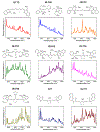Noninvasive and Highly Multiplexed Five-Color Tumor Imaging of Multicore Near-Infrared Resonant Surface-Enhanced Raman Nanoparticles In Vivo
- PMID: 34797988
- PMCID: PMC9012519
- DOI: 10.1021/acsnano.1c07470
Noninvasive and Highly Multiplexed Five-Color Tumor Imaging of Multicore Near-Infrared Resonant Surface-Enhanced Raman Nanoparticles In Vivo
Abstract
In vivo multiplexed imaging aims for noninvasive monitoring of tumors with multiple channels without excision of the tissue. While most of the preclinical imaging has provided a number of multiplexing channels up to three, Raman imaging with surface-enhanced Raman scattering (SERS) nanoparticles was suggested to offer higher multiplexing capability originating from their narrow spectral width. However, in vivo multiplexed SERS imaging is still in its infancy for multichannel visualization of tumors, which require both sufficient multiplicity and high sensitivity concurrently. Here we create multispectral palettes of gold multicore-near-infrared (NIR) resonant Raman dyes-silica shell SERS (NIR-SERRS) nanoparticle oligomers and demonstrate noninvasive and five-plex SERS imaging of the nanoparticle accumulation in tumors of living mice. We perform the five-plex ratiometric imaging of tumors by varying the administered ratio of the nanoparticles, which simulates the detection of multiple biomarkers with different expression levels in the tumor environment. Furthermore, since this method does not require the excision of tumor tissues at the imaging condition, we perform noninvasive and longitudinal imaging of the five-color nanoparticles in the tumors, which is not feasible with current ex vivo multiplexed tissue analysis platforms. Our work surpasses the multiplicity limit of previous preclinical tumor imaging methods while keeping enough sensitivity for tumor-targeted in vivo imaging and could enable the noninvasive assessment of multiple biological targets within the tumor microenvironment in living subjects.
Keywords: cancer imaging; in vivo imaging; multiplexed imaging; surface-enhanced Raman spectroscopy; surface-enhanced resonant Raman scattering.
Conflict of interest statement
The authors declare no competing financial interest.
Figures





Similar articles
-
Multiplexing potential of NIR resonant and non-resonant Raman reporters for bio-imaging applications.Analyst. 2023 Nov 20;148(23):5915-5925. doi: 10.1039/d3an01298k. Analyst. 2023. PMID: 37850265 Free PMC article.
-
Non-invasive In Vivo Imaging of Cancer Using Surface-Enhanced Spatially Offset Raman Spectroscopy (SESORS).Theranostics. 2019 Aug 13;9(20):5899-5913. doi: 10.7150/thno.36321. eCollection 2019. Theranostics. 2019. PMID: 31534527 Free PMC article.
-
Multiplexed imaging of surface enhanced Raman scattering nanotags in living mice using noninvasive Raman spectroscopy.Proc Natl Acad Sci U S A. 2009 Aug 11;106(32):13511-6. doi: 10.1073/pnas.0813327106. Epub 2009 Jul 28. Proc Natl Acad Sci U S A. 2009. PMID: 19666578 Free PMC article.
-
Advances in Surface Enhanced Raman Spectroscopy for in Vivo Imaging in Oncology.Nanotheranostics. 2022 Jan 1;6(1):31-49. doi: 10.7150/ntno.62970. eCollection 2022. Nanotheranostics. 2022. PMID: 34976579 Free PMC article. Review.
-
Single-molecule and single-nanoparticle SERS: from fundamental mechanisms to biomedical applications.Chem Soc Rev. 2008 May;37(5):912-20. doi: 10.1039/b708839f. Epub 2008 Mar 26. Chem Soc Rev. 2008. PMID: 18443676 Review.
Cited by
-
In vivo surface-enhanced Raman scattering techniques: nanoprobes, instrumentation, and applications.Light Sci Appl. 2025 Feb 11;14(1):79. doi: 10.1038/s41377-024-01718-5. Light Sci Appl. 2025. PMID: 39934124 Free PMC article. Review.
-
A Permeabilization Workflow To Enable Specific Multiplexed Profiling Using SERS Nanoparticles.ACS Appl Mater Interfaces. 2025 Jul 2;17(26):37747-37762. doi: 10.1021/acsami.5c08079. Epub 2025 Jun 17. ACS Appl Mater Interfaces. 2025. PMID: 40525305 Free PMC article.
-
Near-infrared II plasmonic porous cubic nanoshells for in vivo noninvasive SERS visualization of sub-millimeter microtumors.Nat Commun. 2022 Sep 6;13(1):5249. doi: 10.1038/s41467-022-32975-w. Nat Commun. 2022. PMID: 36068273 Free PMC article.
-
Advancing SERS as a quantitative technique: challenges, considerations, and correlative approaches to aid validation.Nano Converg. 2024 Aug 17;11(1):33. doi: 10.1186/s40580-024-00443-4. Nano Converg. 2024. PMID: 39154073 Free PMC article. Review.
-
Molecular jackhammers eradicate cancer cells by vibronic-driven action.Nat Chem. 2024 Mar;16(3):456-465. doi: 10.1038/s41557-023-01383-y. Epub 2023 Dec 19. Nat Chem. 2024. PMID: 38114816
References
Publication types
MeSH terms
Substances
Grants and funding
LinkOut - more resources
Full Text Sources
Medical
Miscellaneous

